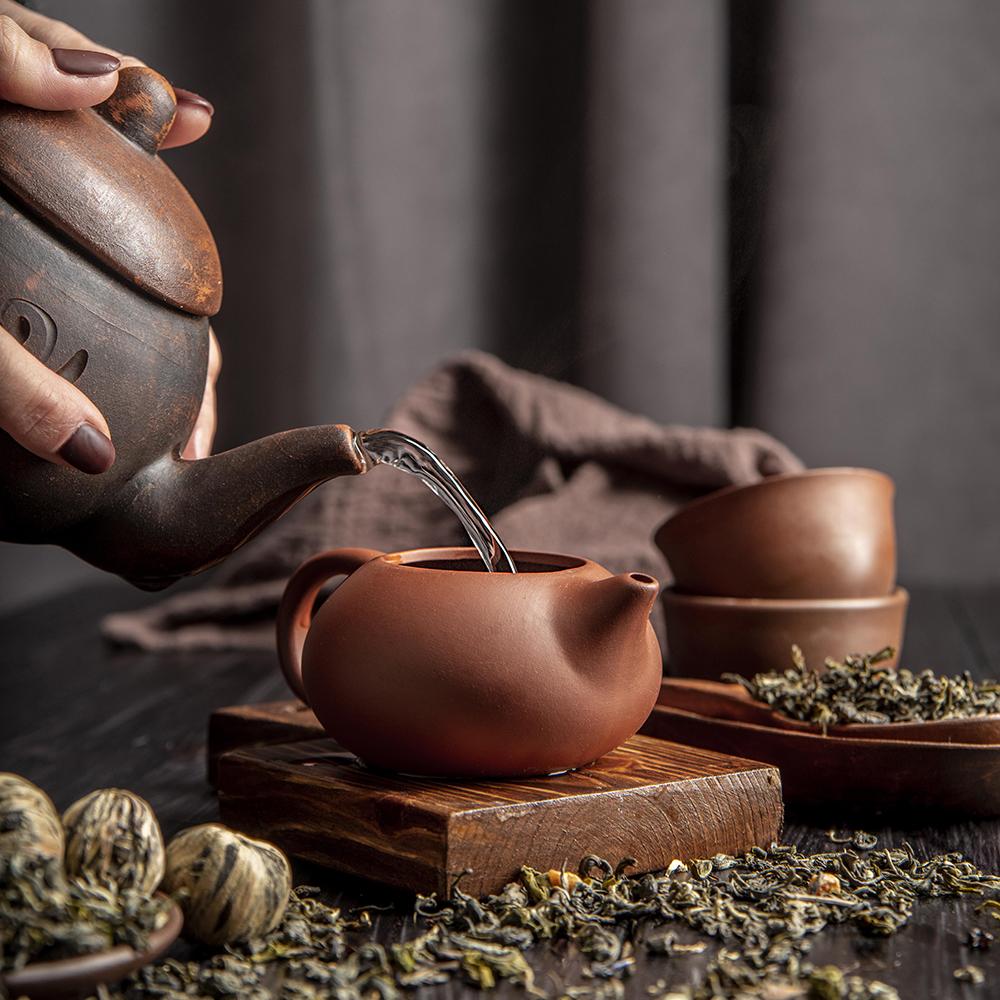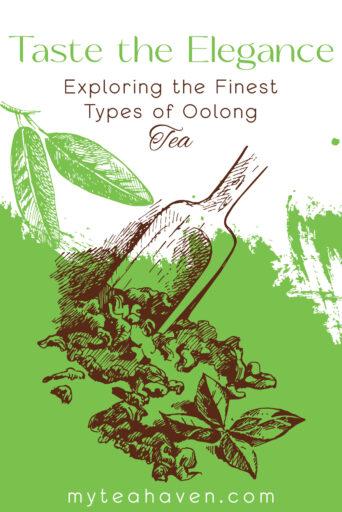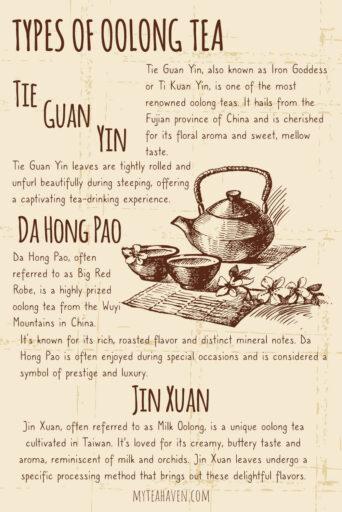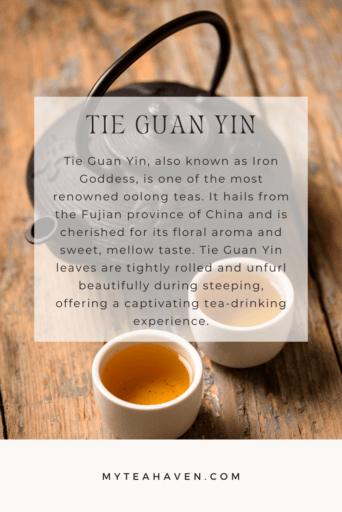Taste the Elegance: Exploring the Finest Types of Oolong Tea
Types of Oolong Tea
With its partial oxidation and unique processing methods, there are many types of oolong tea that are sure to delight any tea connoisseur! Today I will take you on a journey through the fascinating world of oolong tea, exploring its different types, flavor profiles, brewing techniques, and much more. So, grab your teacup, sit back, and let’s dive into the enchanting realm of oolong tea.
We are a participant in the Amazon Services LLC Associates Program, an affiliate advertising program designed to provide a means for us to earn fees by linking to Amazon.com and related sites. This post may contain affiliate links which means we may receive a commission, at no cost to you, for purchases made using our links. Please see my disclosure to learn more. Unless otherwise stated, all prices are in US$.
Introduction to Oolong Tea
Oolong tea, which is also known as “wulong” tea, is a traditional Chinese tea that falls between green and black tea in terms of oxidation.
It undergoes a unique processing technique that involves withering, oxidation, fixation, rolling, and drying.
This meticulous craftsmanship creates a tea that is complex, aromatic, and offers a wide range of flavors.

What is Oolong Tea?
Oolong tea is made from the leaves of the Camellia sinensis plant, the same plant that gives us black, green, and white teas. What sets oolong tea apart is its unique processing method, which includes partial oxidation.
The oxidation level of oolong tea can vary from 10% to 80%, resulting in a wide spectrum of flavors. The leaves used for oolong tea are carefully selected and harvested, ensuring the highest quality in every cup.
Processing Methods of Oolong Tea
The unique processing methods of oolong tea contribute to its distinct flavor and aroma. Let’s take a closer look at the steps involved in creating this extraordinary tea:
Withering
After harvest, the freshly plucked tea leaves are spread out to wither. This step reduces moisture content and prepares the leaves for oxidation.
Oxidation
Oxidation is a crucial step in oolong tea production. The leaves are allowed to oxidize under controlled conditions. The level of oxidation determines the flavor and color of the tea.
Fixation
To halt the oxidation process, the leaves are heated or steamed. This fixation step ensures that the desired level of oxidation is achieved.
Rolling
The withered and oxidized leaves are gently rolled to shape them into tight, curly balls or twisted strands. Rolling helps release the tea’s natural oils and flavors.
Drying
Finally, the rolled leaves are dried to stop further oxidation and moisture absorption. This step preserves the quality and shelf life of the tea.
Types of Oolong Tea
Oolong tea encompasses a wide variety of types, each with its own unique characteristics. Let’s explore some of the most popular types of oolong tea:
Tie Guan Yin (Iron Goddess)
Tie Guan Yin, also known as Iron Goddess or Ti Kuan Yin, is one of the most renowned oolong teas. It hails from the Fujian province of China and is cherished for its floral aroma and sweet, mellow taste. Tie Guan Yin leaves are tightly rolled and unfurl beautifully during steeping, offering a captivating tea-drinking experience.
Da Hong Pao (Big Red Robe)
Da Hong Pao, often referred to as Big Red Robe, is a highly prized oolong tea from the Wuyi Mountains in China. It is known for its rich, roasted flavor and distinct mineral notes. Da Hong Pao is often enjoyed during special occasions and is considered a symbol of prestige and luxury.

Oriental Beauty
Oriental Beauty, also called Bai Hao Oolong or Dong Fang Mei Ren, is a unique oolong tea from Taiwan. It’s known for its delicate fruity and honey-like flavors, with a hint of muscat grape. The leaves of Oriental Beauty undergo natural insect biting, which enhances the tea’s flavor and aroma.
High Mountain Oolong
High Mountain Oolong refers to oolong teas grown at high altitudes in Taiwan, typically above 1,000 meters. These teas are known for their unique floral and creamy flavors, as well as their smooth and buttery texture. High Mountain Oolongs are highly sought after by tea lovers for their exceptional quality.
Phoenix Dan Cong
Phoenix Dan Cong, originating from the Phoenix Mountain in China’s Guangdong province, is a remarkable oolong tea with a wide range of flavors. It’s renowned for its fruity, floral, and honey-like aromas. Each Phoenix Dan Cong tea is named after the specific fruit or flower scent it exudes, such as honey orchid, almond, or osmanthus.
Dong Ding
Dong Ding, also known as Tung Ting, is a famous Taiwanese oolong tea. It offers a smooth, buttery texture with a slightly roasted flavor.
Dong Ding is appreciated for its balanced taste and long-lasting aftertaste, making it a favorite among tea connoisseurs.

Jin Xuan (Milk Oolong)
Jin Xuan, often referred to as Milk Oolong, is a unique oolong tea cultivated in Taiwan.
It’s loved for its creamy, buttery taste and aroma, reminiscent of milk and orchids.
Jin Xuan leaves undergo a specific processing method that brings out these delightful flavors.
Wuyi Rock Tea
Wuyi Rock Tea, also known as Yancha or Rock Oolong, is grown in the Wuyi Mountains of Fujian, China. It’s famous for its robust, mineral-rich flavor and unique rocky undertones. Wuyi Rock Tea leaves are traditionally roasted over charcoal, adding depth and complexity to the tea’s taste.
Baozhong

Baozhong, sometimes spelled Pouchong, is a lightly oxidized tea from Taiwan. It’s considered to be its own type of tea by some, but also frequently classified as a type of oolong tea.
It is characterized by its floral aroma, mild taste, and pale-yellow liquor. Baozhong is often enjoyed as an afternoon tea due to its light and refreshing nature.
Guangdong Oolong
Hailing from the Guangdong province in China, Guangdong Oolong teas are known for their unique production techniques and distinct flavors. These teas often undergo a process called “Gongfu,” which involves multiple short infusions to bring out the tea’s complex flavors and aromas.
Flavor Profiles and Aromas of Oolong Tea
The flavor profiles and aromas of oolong tea vary greatly depending on the type and processing methods. Oolong teas can range from floral and fruity to roasted and earthy, offering a broad spectrum of tastes to explore. Some oolong teas may exhibit notes of orchid, jasmine, peach, honey, caramel, or even toasted nuts. The diversity in flavors makes oolong tea a versatile and exciting beverage to enjoy.
How to Brew Oolong Tea
Brewing oolong tea requires a delicate touch to bring out its exquisite flavors. Here’s a simple guide to brewing the perfect cup of oolong tea:
- Start with high-quality oolong tea leaves. The amount of tea leaves can vary based on personal preference, but a general guideline is 1 teaspoon per 8 ounces of water.
- Heat water to around 190-200°F (88-93°C). Avoid boiling water, as it can scorch the leaves and result in a bitter taste.
- Rinse your teapot or teacup with hot water to warm it up.
- Add the oolong tea leaves to the teapot or teacup.
- Pour the hot water over the leaves and let them steep for 2 to 3 minutes. Adjust the steeping time based on your preference and the specific type of oolong tea you’re brewing.
- As oolong tea leaves can be steeped multiple times, you can enjoy several infusions from the same leaves. Increase the steeping time slightly with each subsequent infusion.
- Once the desired flavor is achieved, pour the tea into your teacup and savor the delightful aromas and tastes of oolong tea.

Pairing Oolong Tea With Food
The versatile flavors of oolong tea make it a fantastic beverage to pair with various types of cuisine. Here are some pairing suggestions to enhance your tea-drinking experience:
- Floral oolong teas, such as Tie Guan Yin, complement light and delicate foods like sushi, steamed fish, or fresh salads.
- Roasted oolongs, like Da Hong Pao, pair well with roasted meats, grilled vegetables, and hearty dishes.
- Fruity oolongs, such as Oriental Beauty, can be enjoyed alongside desserts, pastries, or tropical fruits.
- Creamy and buttery oolongs, like Jin Xuan, go well with creamy cheeses, buttered pastries, or milk chocolate.
Feel free to experiment and discover your own favorite flavor combinations. The possibilities are endless!
The Best Oolong Teas for Different Occasions
When it comes to choosing the best oolong tea for a specific occasion, personal preference plays a significant role. That being said, here are a few recommendations to guide you:
- For a relaxing afternoon tea session, go for a delicate and floral oolong, such as Tie Guan Yin or Baozhong.
- If you’re seeking a tea with bold flavors to accompany a hearty meal, go for a roasted oolong like Da Hong Pao or Wuyi Rock Tea.
- For a special occasion or when entertaining guests, consider serving a rare and prized oolong tea, such as Oriental Beauty or Phoenix Dan Cong.
Remember, the best oolong tea is the one that brings you joy and suits the occasion.
Where to Buy Oolong Tea
Finding high-quality oolong tea is crucial to fully appreciate its nuances and flavors. Here are a few places where you can purchase oolong tea:
- Specialty tea shops: Local tea shops often carry a selection of oolong teas, allowing you to sample and choose based on your preferences.
- Online tea retailers: Numerous online retailers offer a wide range of oolong teas from different regions, providing convenience and access to teas from around the world.
- Tea estates and farms: Some tea estates and farms offer direct sales, ensuring freshness and authenticity. Visiting a tea farm can also provide a unique experience and insight into the tea-making process.
When purchasing oolong tea, look for reputable sellers who prioritize quality, provide detailed information about the tea’s origin and processing, and offer customer reviews or ratings.
A Few Final Thoughts

Oolong tea is a captivating beverage that offers an array of flavors, aromas, and delights. From the delicate floral notes of Tie Guan Yin to the rich roasted flavors of Da Hong Pao, the world of oolong tea is a treasure trove for tea enthusiasts.
Exploring the diverse types of oolong tea and savoring their unique characteristics is a delightful journey that allows you to discover your personal favorites.
So, embrace the elegance of oolong tea, brew a cup of your chosen variety, and let its enchanting flavors transport you to a world of sensory bliss.
Some Questions You Might Have
- Is oolong tea caffeinated?
Yes, oolong tea contains caffeine. The exact amount of caffeine can vary depending on the specific type of oolong tea and how it is brewed. However, oolong tea generally contains less caffeine than black tea but more caffeine than green tea.
- Can oolong tea help with weight loss?
Oolong tea has been associated with potential weight loss benefits due to its ability to boost metabolism and aid in fat oxidation. That being said, it’s important to note that oolong tea alone is not a magical weight loss solution. Incorporating oolong tea as part of a balanced diet and active lifestyle may contribute to weight management.
- How should I store oolong tea to maintain its freshness?
To preserve the freshness and flavors of oolong tea, it is recommended to store it in an airtight container away from direct sunlight, moisture, and strong odors. Ideally, store the tea in a cool, dark place. Avoid storing it in the refrigerator, as the tea can absorb moisture and odors from other foods.
- Can I reuse oolong tea leaves for multiple infusions?
Yes, oolong tea leaves can often be steeped multiple times, each time offering a different flavor profile. Increase the steeping time slightly with each subsequent infusion to extract the full potential of the leaves. Experiment and discover how the flavors evolve with each brew.
- Are there any side effects of consuming oolong tea?
For most people, consuming oolong tea in moderate amounts is safe and well-tolerated. However, oolong tea does contain caffeine, so individuals who are sensitive to caffeine or have underlying health conditions should consume it in moderation. It’s always advisable to consult with a healthcare professional if you have any specific concerns or medical conditions.









